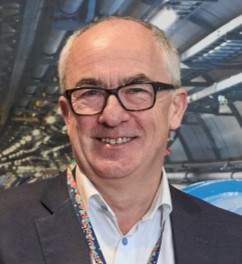In my first months as Director-General Designate, I’ve been privileged to have enriching discussions with the current Management and have consulted widely across the Organization. Meeting so many brilliant and committed colleagues has been a real inspiration, and I wish to take this opportunity to thank you all for such a warm welcome to CERN.
The input that I have received over the past months has helped me to define CERN’s Directorate structure for 2026–2030, which was endorsed at the March CERN Council session. Here, I would like to explain briefly what is going to change from 2026 and, just as importantly, what is not.
The endorsed structure outlines the different sectors, but I have not yet taken any decisions on the future Directors themselves. I intend to present the nominations for the Directors to the CERN Council in June, and the nominations for the Department Heads at the Council session in September. I would like to thank all members of CERN Council for their support and endorsement of this first step.
CERN priorities for 2026–2030
In considering the new structure, I felt it important to avoid making changes for the sake of change, and my reflections for my upcoming mandate are as much about management culture and practices as they are about structure. Ultimately, the new structure is motivated by the Organization’s key priorities for the coming years.
I believe that CERN’s main scientific priorities for 2026–2030 will be:
- Completing the High Luminosity LHC (HL-LHC) and the timely completion of the upgrades of the ATLAS and CMS experiments. This must be our collective top priority.
- Building consensus through the European Strategy for Particle Physics (ESPP) process for the Future Circular Collider (FCC) or an alternative flagship project for CERN.
- Proactively engaging with key stakeholders to consolidate the collective sense of ownership and build political consensus for CERN’s long-term future.
- Progressing with the planning and decision making for proposed upgrades of the ALICE and LHCb experiments.
- Developing a long-term vision and roadmap to exploit the CERN injector complex, in order to deliver an exciting, diverse programme of experiments for Physics Beyond Colliders.
Beyond the HL-LHC, many other activities will, of course, be taking place during the coming Long Shutdown (LS3), including consolidation and operation of the injector complex.
Management structure for 2026–2030
As Director-General, I will be supported by a team of five Directors, each responsible for a sector:
- The Accelerators and Technology sector will remain largely unchanged, with the current four departments remaining, as I firmly believe that the risk of introducing delays due to disruption from restructuring outweighs any potential gains. Nonetheless, some increased priority will need to be given to support the installation of the ATLAS and CMS upgrades.
- The Research and Computing sector will also remain largely unchanged, but with an enhanced focus on supporting the installation of the ATLAS and CMS upgrades.
- The Stakeholder Relations sector will replace the current International Relations sector, with a somewhat broader scope to reflect key activities towards the realisation of the FCC, should it be prioritised by the ESPP. For example, increased emphasis will be placed on our Member States, the Host States and the European Union.
- The Finance and Human Resources sector will see some changes in scope, the main one being that the Site and Civil Engineering (SCE) department will move to a new Site Operations sector.
- The Site Operations sector will be a new sector and the Director’s role will be similar to that of a traditional Chief Operation Officer (COO), focusing on those operational activities, such as SCE, that span multiple sectors. Some fine details of the full scope of this new sector will be developed when the new Director is selected.
In addition, I will introduce a new non-departmental role of Chief Information Officer (CIO), reporting directly to the Director-General. This strongly aligns with the recommendations from the Audit Committee concerning cross-organisational authority for governance of IT-related activities. Nevertheless, as is the case now, the resources for these IT-related activities and the responsibility for their delivery will remain within the relevant sectors.
Looking beyond the structure
The broad range of the activities that will take place in LS3 should not be underestimated. Success will rely upon CERN’s incredible personnel, the wider scientific community and other partners. With many LS3 activities running in parallel, how we work together will be at least as important as the management structure. I always strive to lead collaboratively and intend to further embed the culture of trust and empowerment at CERN, with decisions being systemically delegated to, and taken at, the appropriate level. I have always found it important to provide clarity and transparency in decision making and in setting organisational priorities, with effective internal communication. This will ensure that we have a clear collective understanding of the main priorities for CERN so that we can work together as a community to deliver our main goals.
Building on the solid foundation of the current CERN management objectives, we will continue the Organization’s commitment to address imbalances in industrial and personnel return to the Member States for CERN’s long-term future. I also want to strengthen support for CERN users, other associated members of the personnel, and the major experiment collaborations to foster the best possible environment to ensure the success of the HL-LHC, including the experiment upgrades.
Next steps
Over the coming months, I will be fine-tuning my plans and will continue discussions with the current Management and with colleagues across the Organization. We have an exciting time ahead of us and I am looking forward to working together with colleagues across CERN and with our key stakeholders to deliver our priorities.

